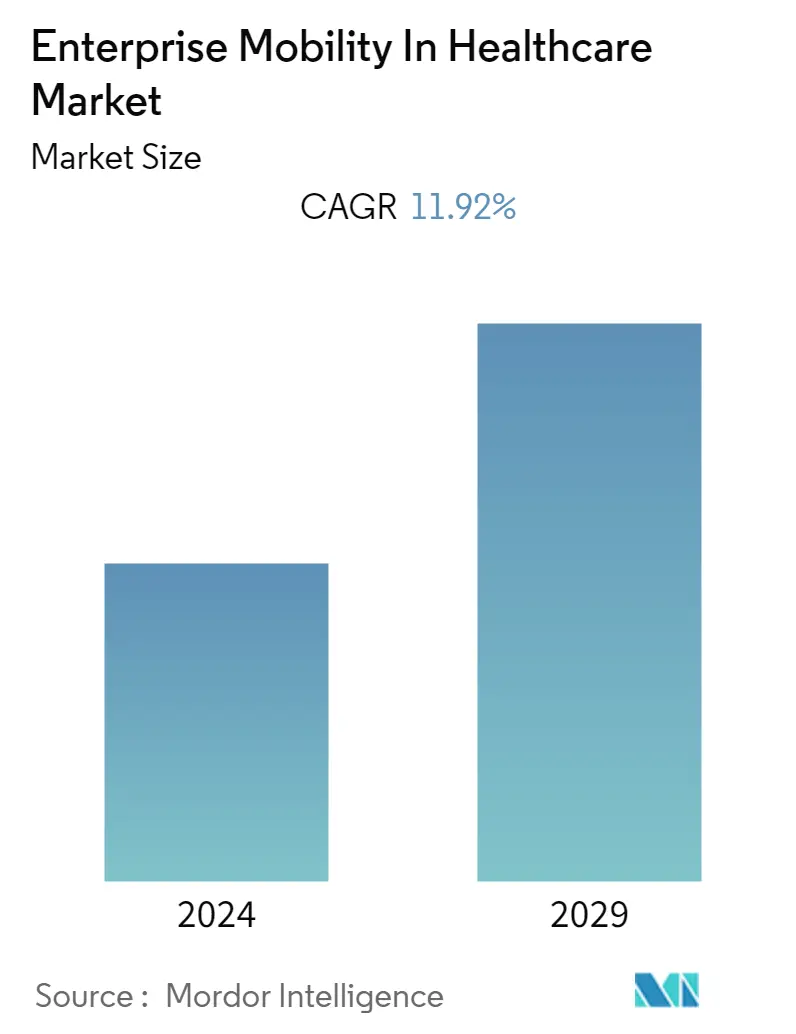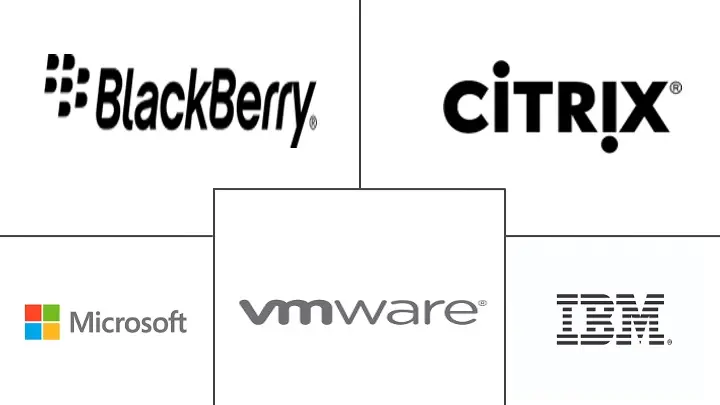Market Size of Enterprise Mobility In Healthcare Industry

| Study Period | 2022 - 2029 |
| Base Year For Estimation | 2023 |
| CAGR (2024 - 2029) | 11.92 % |
| Fastest Growing Market | Asia Pacific |
| Largest Market | North America |
| Market Concentration | Medium |
Major Players
*Disclaimer: Major Players sorted in no particular order |
Enterprise Mobility In Healthcare Market Analysis
The Enterprise Mobility In Healthcare Market is expected to register a CAGR of 11.92% during the forecast period(2024-2029).
- The healthcare sector is witnessing a remarkable transformation due to mobile technology advancements. With the concerns associated with privacy and security being met effectively compared to earlier, enterprise mobility management (EMM) is witnessing significant adoption in the healthcare industry.
- Factors such as mobile devices being the preferred medium of accessing the internet, enterprise data, and various other information, continuous pressure to cut costs, and the rising trend of bring-your-own-device (BYOD) across numerous healthcare facilities are driving the market growth.
- Various services such as management of mobile devices (tablets, smartphones, or laptops), applications, information, and remote support are provided as a part of enterprise mobility management solutions in addressing the challenges and providing quick and improved decision making, improved treatment, and reduced readmissions, increased productivity, higher accuracy, time and cost-saving.
- The deployment of EMM in healthcare systems enables tackling challenges, such as the traditional way of managing patient records. EMM enables the storage of health records, like prescriptions, lab results, medical history, medications, and more, in a paperless way. This allows quick and easy access to patient health records, allowing the physicians to quickly check a patient's background during emergencies and provide easy information updates.
- However, issues about identity and access management (IAM), which involves granting access to sensitive information only to authenticated sources, could be quite challenging and could pose a security risk. Additionally, the growing adoption of remote patient monitoring systems in the healthcare industry by professionals is expected to fuel the demand growth for Enterprise Mobility in Healthcare Market during the forecast period.
- Growing adoption of smartphones and tablets in healthcare systems, rising focus on patient-centric mobility applications, advanced connectivity to enhance the quality of healthcare solutions, better cost efficiency of mobility solutions resulting in a streamlined workflow, shortage of nursing staff and doctors enhancing the adoption of mobility solutions, and robust penetration of wireless networks such as 2G and 3G are factors fuelling the growth of this market. However, data security issues, short battery life of mobile computers, lack of standard communication protocols and reimbursement policies, and infrastructural and cost issues pose major challenges to the growth of the healthcare mobility solutions market.
- The healthcare mobility solutions market is segmented on the basis of products and services, applications, and end users. Based on products and services, the market is segmented into mobile devices, mobile applications, and enterprise platforms. The mobile devices market covers mobile computers, radio frequency identification (RFID) scanners, barcode scanners, and others. On the basis of applications, the market is classified into patient care management, operations management, and workforce management. By end users, the market is divided into payers, providers, and patients.
Enterprise Mobility In Healthcare Industry Segmentation
Enterprise mobility management (EMM) comprises a set of tools and technologies to maintain and manage mobile or handheld devices used within an organization during routine business operations. The EMM exhaustively considers the mobile device, access, and application management as part of our market analysis.
The enterprise mobility in the healthcare market is segmented by solution (mobile device management, mobile application management, mobile content management, identity and access management) and geography (North America, Latin America, Europe, Asia-Pacific, and the Middle East and Africa.
The market sizes and forecasts are provided in terms of value in USD for all the above segments.
| By Solution | |
| Mobile Device Management | |
| Mobile Application Management (MAM) | |
| Mobile Content Management (MCM) | |
| Identity and Access Management (IAM) |
| By Geography*** | |
| North America | |
| Europe | |
| Asia | |
| Latin America | |
| Middle East and Africa |
Enterprise Mobility In Healthcare Market Size Summary
The enterprise mobility in healthcare market is experiencing significant growth, driven by advancements in mobile technology and the increasing adoption of mobile devices within healthcare settings. This transformation is largely due to the effective management of privacy and security concerns, which has facilitated the widespread adoption of enterprise mobility management (EMM) solutions. These solutions are essential for managing mobile devices, applications, and information, enabling healthcare providers to improve decision-making, enhance patient care, and streamline operations. The trend towards bring-your-own-device (BYOD) policies further propels market expansion, as healthcare professionals increasingly use personal devices to access enterprise data and applications. Despite challenges such as data security issues and the need for robust identity and access management, the market continues to grow, supported by the rising demand for remote patient monitoring and the integration of mobile health applications.
Regionally, North America holds a significant share of the healthcare enterprise mobility market, bolstered by a strong presence of key industry players and supportive government initiatives. The region's advanced healthcare infrastructure and technological advancements contribute to the market's robust growth. The proliferation of smartphones and tablets, along with the increasing focus on digital health, further drives market expansion. Companies like Cisco Systems, IBM Corporation, and Microsoft Corporation are actively engaged in innovation to meet the evolving needs of healthcare providers. Recent strategic moves, such as acquisitions and the introduction of new mobility solutions, underscore the growing importance of enterprise mobility in healthcare. These developments highlight the sector's potential for continued growth, as healthcare providers increasingly rely on mobile technologies to enhance service delivery and improve patient outcomes.
Enterprise Mobility In Healthcare Market Size - Table of Contents
-
1. MARKET INSIGHTS
-
1.1 Market Overview
-
1.2 Industry Attractiveness - Porter's Five Forces Analysis
-
1.2.1 Bargaining Power of Suppliers
-
1.2.2 Bargaining Power of Consumers
-
1.2.3 Threat of New Entrants
-
1.2.4 Intensity of Competitive Rivalry
-
1.2.5 Threat of Substitute Products
-
-
1.3 Assessment of the Impact of COVID-19 on the Market
-
-
2. MARKET SEGMENTATION
-
2.1 By Solution
-
2.1.1 Mobile Device Management
-
2.1.2 Mobile Application Management (MAM)
-
2.1.3 Mobile Content Management (MCM)
-
2.1.4 Identity and Access Management (IAM)
-
-
2.2 By Geography***
-
2.2.1 North America
-
2.2.2 Europe
-
2.2.3 Asia
-
2.2.4 Latin America
-
2.2.5 Middle East and Africa
-
-
Enterprise Mobility In Healthcare Market Size FAQs
What is the current Enterprise Mobility In Healthcare Market size?
The Enterprise Mobility In Healthcare Market is projected to register a CAGR of 11.92% during the forecast period (2024-2029)
Who are the key players in Enterprise Mobility In Healthcare Market?
Vmware Inc., Citrix Systems Inc., IBM Corporation, Microsoft Corporation and BlackBerry Limited are the major companies operating in the Enterprise Mobility In Healthcare Market.

